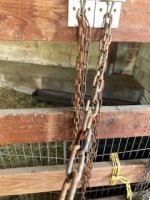Baymule
Herd Master
We get the north wind off the high plains. Brrrrr. Yup, kinda directional oriented here. Seriously, you should predator proof the rabbit barn, same as you would a chicken coop. I’ll shut up now.
I probably will "predator proof" the rabbit shed....but for different reasons than you are thinking. I'll explain that in @Xerocles rabbit thread in the next day or so.We get the north wind off the high plains. Brrrrr. Yup, kinda directional oriented here. Seriously, you should predator proof the rabbit barn, same as you would a chicken coop. I’ll shut up now.
 Hooks need to be sturdy enough to support 200 lbs. That is when you over balance while trying to catch that doe and fall into or onto the cage, grabbing the chain to keep from crashing to the ground. Try to be alone when this happens or your family will bring up the time mom got stick in the rabbit cage at family gatherings.
Hooks need to be sturdy enough to support 200 lbs. That is when you over balance while trying to catch that doe and fall into or onto the cage, grabbing the chain to keep from crashing to the ground. Try to be alone when this happens or your family will bring up the time mom got stick in the rabbit cage at family gatherings.  Chains need to be sturdy to hold 200 lbs. See above, also remember that the doe and her litter of 8-10 kits will weigh over 60 lbs. Add in the food dishes, next boxes, etc. and you will see after you finish reading the instructions why I recommend a 200 lbs.
Chains need to be sturdy to hold 200 lbs. See above, also remember that the doe and her litter of 8-10 kits will weigh over 60 lbs. Add in the food dishes, next boxes, etc. and you will see after you finish reading the instructions why I recommend a 200 lbs. Here is our old rabbitry which was very functional and easy to keep clean. You can see the cages are hung from chains at the corners. The J feeders are 12" screen bottom. You can see the privacy panels between the cages and the urine guards on the front. The cages all have cage card holders which take a 3" x 5" recipe card and the cards can be moved with the rabbits when they are moved to different cages in the rabbitry. You can't see the watering system because at this time I was using a combination automatic system which used pvc pipes and drinkers mounted at the back of the cages. In other parts of the barn I used flexble tubing and drinker valves.
Here is our old rabbitry which was very functional and easy to keep clean. You can see the cages are hung from chains at the corners. The J feeders are 12" screen bottom. You can see the privacy panels between the cages and the urine guards on the front. The cages all have cage card holders which take a 3" x 5" recipe card and the cards can be moved with the rabbits when they are moved to different cages in the rabbitry. You can't see the watering system because at this time I was using a combination automatic system which used pvc pipes and drinkers mounted at the back of the cages. In other parts of the barn I used flexble tubing and drinker valves. God bless you for this information! Very helpful. Now, where were you when I needed you?OK. We had over 100 hanging cages in our old rabbitry. All wire, all hung from chains. Minimal sway. Automatic water lines from cage to cage. I hung them all.all

A rabbit needs a good-sized hutch or cage preferably with two compartments. ... The floor should be covered with newspaper with a layer of bedding material placed on top of the newspaper (straw, grass hay or shredded paper) to provide warmth, comfort and to prevent the rabbit from developing pressure sores on their feet.Rabbit cages. All wire. Suspended.
Why didn't you guys warn me?
A. That it takes at least three people to hang,
level, and align them? I had to build a frame tall enough to set them on, first. Even then, its a nightmare to adjust the
Chains so they're level all the way around.
B. How to stop them from swinging? 4 or 6. chains per cage (depending on length). And everytime I touch them, they swing. Poor bunnies are going to have chronic sea-sickness. Can you even GIVE rabbit Dramamine? I want lots of kits, but how do I stop the bunnies from being. "swingers"?
I know. You guys were sitting back chuckling, saying "wait til he trys hanging them. He'll come crawling back, begging for our help,"
Well.......HELP!!!
I suggest you ask @Ridgetop all your breeding questions! He cleary had it down to a science! I have a binder for my breeder info, but, sometimes it does slip my mind to write it down...I was going to ask the same question!!God bless you for this information! Very helpful. Now, where were you when I needed you?
Just finished hanging all my cages today. Not nearly as efficiently as what you describe, though. I looked mightly for a 5 yr old for a support and couldn't find one.
One question, when using water bottles, you suggest using 1/8 spoonful....but failed to say what. I am guessing apple cider vinegar?
It's a pretty basic, right? whether what kind of animal it is. it needs to have a proper house or location. no questions. I always make sure they are safe. I love them and I prioritize them.We get the north wind off the high plains. Brrrrr. Yup, kinda directional oriented here. Seriously, you should predator proof the rabbit barn, same as you would a chicken coop. I’ll shut up now.